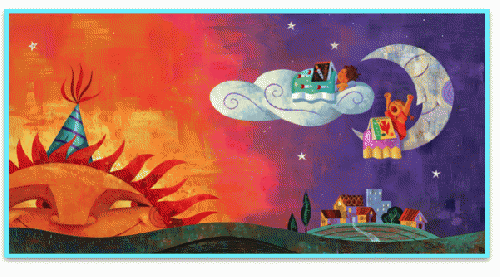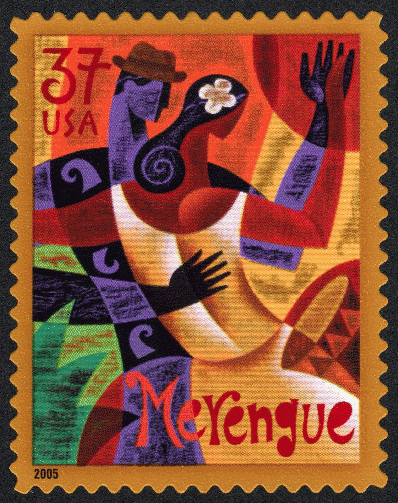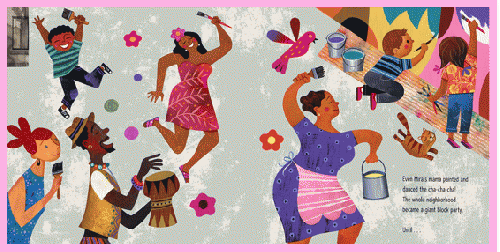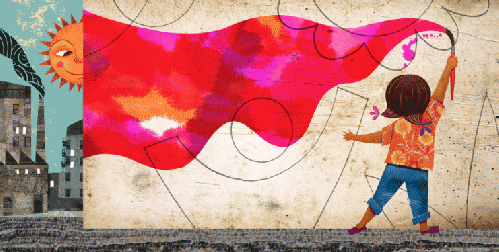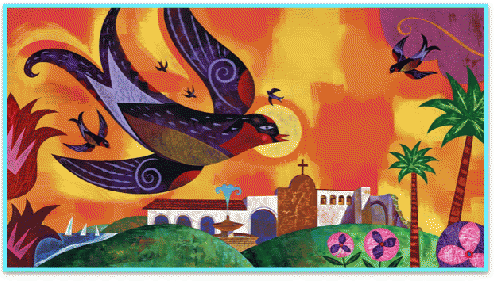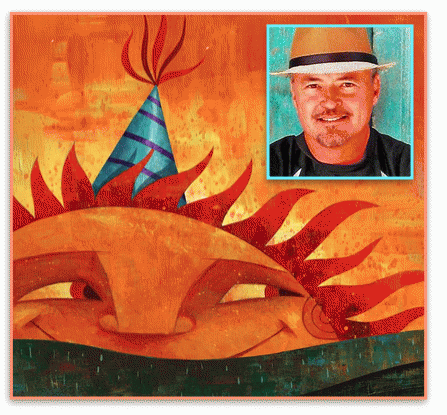| Back OpEd News | |||||||
|
Original Content at https://www.opednews.com/articles/Transforming-the-Urban-Lan-by-Meryl-Ann-Butler-Artists-170201-79.html (Note: You can view every article as one long page if you sign up as an Advocate Member, or higher). |
|||||||
February 1, 2017
Transforming the Urban Landscape: An Interview with Artist Rafael Lopez
By Meryl Ann Butler
Rafael Lopez is a muralist and illustrator whose artwork has changed both the urban landscape and the landscape of children's literature. His newest book beautifully depicts how anyone can change the environment they live in for the better.
::::::::
Rafael Lopez is an award-winning children's book illustrator and muralist with studios in San Diego, CA, and San Miguel de Allende, Mexico.
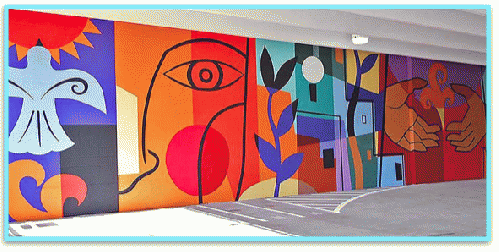
Community Mural in downtown Fort Collins, Colorado painted in 2011 with the community of Fort Collins and the students from 'Imaginantes,' a program by the Poudre Library System which invites students to participate in the arts every summer.
(Image by Rafael Lopez) Details DMCA
He and his wife Candice, a Professor of Art and Design, cofounded the Urban Art Trail movement in San Diego's East Village. With community involvement, the project midwifed several joyful public art murals that beautified the area, resulting in enhanced community interactions, revitalizing neighborhoods through the power of images.
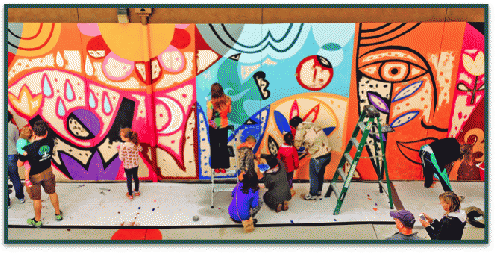
Community mural created for the San Diego Cooperative Charter School Campus 2 with the help from students, parents and people from the neighborhood. 2016.
(Image by Rafael Lopez) Details DMCA
As well as uplifting spirits and inspiring creativity, public art has distinctly measurable social benefits. Studies have shown that public art murals can help reduce vandalism and petty crime as well as increase property values and neighborhood pride.
In the book illustration arena, Lopez' wildly joyful and energetic picture book art has won him many awards, including two Pura Belpre' medals from the American Library Association, for Drum Dream Girl (2016) and Book Fiesta (2010).
In 2012, he was selected by the Library of Congress to create the National Book Festival poster.
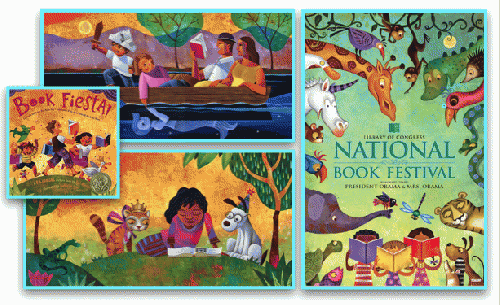
Illustrations from 'Book Fiesta! ¨ by Pat Mora and National Book Festival poster (detail)
(Image by Rafael Lopez) Details DMCA
Meryl Ann Butler: Rafael, thank you so much for visiting with OpEdNews, today! Understanding the power of art in bringing about positive change, I was very excited to find out about your mural projects and the Urban Art Trail movement. I read that in at least some cases you've donated your time to these projects--so I suspect there is a good story behind that passionate choice. What inspired you to begin the Urban Art Trail movement?
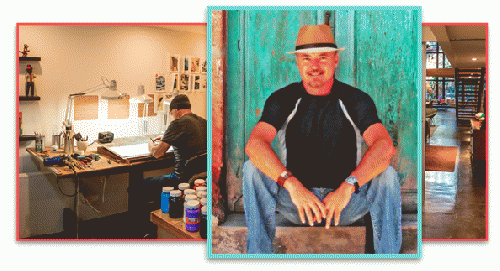
Rafael Lopez in San Miguel Allende, and in his studio in San Diego
(Image by Rafael Lopez) Details DMCA
Rafael Lopez: The start of the Urban Art Trail movement was part inspiration and part desperation!
In 1997 my family purchased an old car garage in an area of downtown San Diego that was edgy. We laid down our savings, determined to renovate the space into into our live/work studio. This task required a lot of perspiration that included scrubbing grime off the industrial floor and pulling old car parts out of the back yard. We focused all our energy and creativity to this project and after long months we pulled it off.
When we stood back and took a deep breath we walked out the front door to realize that out work had just begun. Around us we saw the effects of blight on streets along with crime, walls and sidewalks that wore years of neglect. Neighbors kept their curtains and blinds closed attempting to shut it out and people who passed on the street were afraid to look each other in the eye. Many residents were struggling and walked with a downcast gaze as they moved from place to place.
At first we were unsure of what to do -- that was the desperation part. We organized meetings in our loft, inviting shop owners, people from the redevelopment agency, diverse residents and friends to help us figure this one out.
We realized the best solution was to do what we already knew how to do as artists and work to make our neighborhood visually compelling. I had the idea to devise a mural style that would work like a giant paint-by-numbers so untrained artists could participate. It was important to me that children, seniors, people from all walks of life could be part of the project. The art trail also included painted utility boxes, sculptures, mosaics around tree rings and benches. We created sidewalk poetry to engage those who walked looking down.
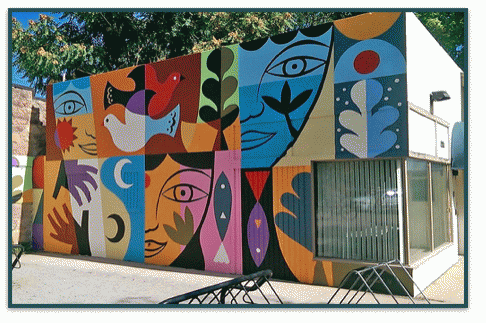
Community mural in Boulder Colorado at the Risk Management building (13th and Arapahoe) created with the collaboration of volunteers, artists, and University Hill Elementary and Boulder High School students.
(Image by Rafael Lopez) Details DMCA
MAB: Wow, hearing this backstory, now I see how it dovetails with your most recent picture book, Maybe Something Beautiful, How Art Transformed a Neighborhood (2016) - that book starts out illustrated in mostly shades of grey, and gradually builds up to a riot of joyful color, like the story you just told of your studio and neighborhood. And it is a hopeful parable for all ages, a reminder that anyone can change the environment they live in for the better.
What an amazing transformation you and Candice and the others who participated created. I'm sure it was lots of work, but it was also quite do-able, with results that seem much greater than the sum of the parts!
What have been the benefits of these public murals, to others as well as to yourself?
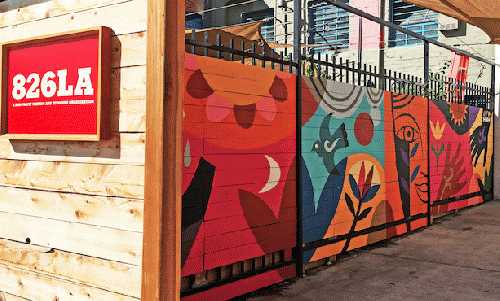
Mural in Echo Park, Los Angeles for 826LA, an organization offering after school activities for kids. Made possible thanks to a collaboration between 826LA, Lead Dog Marketing and Houghton Mifflin Harcourt. 2016.
(Image by Rafael Lopez) Details DMCA
RL: To make real change in a neighborhood it is important to empower others to be part of it.
We posted invitations on graffiti, sent emails and spread the idea via word of mouth asking the community to be part of the process.
Along the way we discovered that neighborhood art breaks down barriers, it connects and brings diverse people together. When locals get involved in designing, creating and taking care of spaces they develop an interest in maintaining them and improve the overall quality of life. They also get to know each other and this good energy attracts new residents and business owners of like mind, promoting interaction in the public space.
Creating community art helps people express and connect to emotions, manage addictions and improve well being.
I was motivated to take mural making on the road especially to hot spots that would benefit from a dose of mindful attention.
One example was in Chicago, the Addison and Avondale mural under a freeway bridge. It was created after an act of violence where children were hurt, and together with that community we painted a 150-foot long mural to reclaim the neighborhood and make people feel safe. Volunteers eventually created a garden beside it and get together regularly to renew and grow friendships.
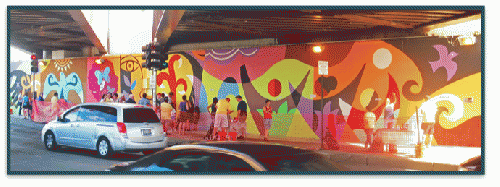
Community mural created in Chicago on the corner of Addison and Avondale after an incident involving a gang shooting. Community leaders got together and now the underpass is crossed safely by parents and students on their way to school. 2011.
(Image by Rafael Lopez) Details DMCA
On a personal level, mural making gave me a chance to impact real change with my work. Having spent many years alone in the studio creating illustrations for clients, this project connected me to people I might never meet and it was fun and meaningful.
I was born in Mexico City and grew up with astounding murals around me from legendary artists like Diego Rivera and Carlos Merida. Murals and community work were a way to bring something unique and authentic from my own culture to share with my diverse neighbors.
MAB: Your work has such a joyful and uplifting quality to it. What is your inspiration for your style?
RL: I've always believed you can't go looking for style because true style finds you. It comes from the inside out after sketching, observing, thinking and listening long enough to that inner voice that whispers in your ear.
I'm influenced by the spirit, surrealism, colors and textures of my native Mexico as well as folk and naieve art from many cultures. I'm passionate about travel and drawn to the clean simplicity of mid-century modernism.
I can't paint or draw without listening to different genres of music, especially Latin jazz.
MAB: Ah-h-h-h, yes, Latin jazz is certainly congruent with your illustration style!
Your community work with murals is the subject of your most recent picture book, Maybe Something Beautiful. I understand that it was one of 33 picture books selected by the New York Public Library for Best Books of 2016. Congratulations! I bought a copy for my granddaughter but haven't been willing to part with it, yet -- I love re-reading it, it is such an uplifting story!
Sometimes, as in this book, the deep truths in childrens' stories are portrayed in a way that is perfect for adults to hear, too, and then it is truly a book for all ages. Can you tell us more about this book, and what you hope your readers will get from it?
Lopez, whose career as a muralist inspired this story, loads each double spread with curves, splashes of paint and geometric shapes, changing page orientation for emphasis at times. As Mira's city comes alive with unforgettable human spirit. The mysterious artist sums it all up "the world is your canvas." An inspiring and wistful message wrapped up in a subtle, thoughtful narrative, and lively beautiful art: Simply superb.
-- Kirkus Starred Review
RL: Making books and meeting diverse kids around the country has taught me that children are wise. They can teach us all a thing or two about getting along. There are so many challenges we face and I want children and adults to feel hope. I want readers of Maybe Something Beautiful to realize they can make a difference right where they live.
I know diversity is a bridge to build trust, enlightenment and innovation. It all begins by encouraging young people to reach their full potential and making sure they can see themselves in the pages of books because life is so much more than a single story. With diverse stories we can go beyond stereotypes and misrepresentations to affirm that each life is different, unique and worthy of being recognized.
MAB: This has been so inspiring, Rafael, thank you.
We do need to feel more hope in America, now, and certainly exhibit more respect for diversity. And your stories, especially Maybe Something Beautiful, offer examples of how one person can choose simple actions that become the source of hope for others, and how that can snowball into something bigger. Timely themes, indeed!
Where is your artistic passion taking you next? Do you have anything else to share with us as we wrap up?
RL: I'm committed to keep telling diverse stories to children.
I'm writing and developing concepts for a book about an unsung personal hero that I greatly admire. I can't wait to tell this story and there are two other books on the drawing table.
This April will see the release of a collaboration with a writer I greatly admire, Margarita Engle, called Bravo! Poems about Amazing Hispanics.
This year I will be creating three murals with children and families and in between I look forward to playing my guitar and doodling with my son Santiago. Sometimes the most exciting ideas come from doodles.
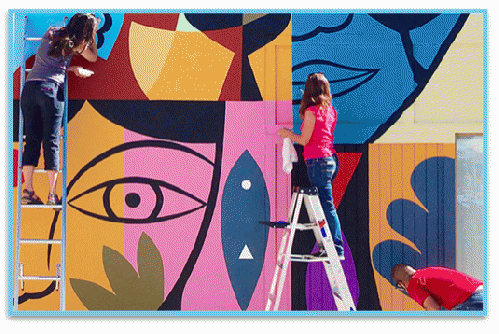
Assistants and volunteers putting the finishing touches on the community mural in downtown Boulder, Colorado. With Charlotte LaSasso.
(Image by Rafael Lopez) Details DMCA
MAB: Thanks so much for visiting with us, Rafael -- for sharing your stories and for adding a splash of your joyful color to OpEdNews!
Books illustrated by Rafael Lopez:
Illustration from 'Book Fiesta! ¨ by Pat Mora, inset Rafael Lopez
(Image by Rafael Lopez) Details DMCAMaybe Something Beautiful
By: F. Isabel Campoy, Theresa Howell
Book Fiesta!
By: Pat Mora
Yum! & Mmmm! Que' Rico!
By: Pat Mora
The Cazuela that the Farm Maiden Stirred
By: Samantha Vamos
My Name is Celia: The Life of Celia Cruz/Me llamo Celia: la vida de Celia Cruz
By: Monica Brown
Tito Puente, Mambo King/Tito Puente, Rey del Mambo
By: Monica Brown
Our California
By: Pam Munoz Ryan
Visit Rafael Lopez' website http://rafaellopez.com
Authors Website: http://www.OceanViewArts.com
Authors Bio:
Meryl Ann Butler is an artist, author, educator and OpedNews Managing Editor who has been actively engaged in utilizing the arts as stepping-stones toward joy-filled wellbeing since she was a hippie. She began writing for OpEdNews in Feb, 2004. She became a Senior Editor in August 2012 and Managing Editor in January, 2013. In June, 2015, the combined views on her articles, diaries and quick link contributions topped one million. She was particularly happy that her article about Bree Newsome removing the Confederate flag was the one that put her past the million mark.
Her art in a wide variety of media can be seen on her YouTube video, "Visionary Artist Meryl Ann Butler on Creativity and Joy" at http://www.youtube.com/watch?v=UcGs2r_66QE
A NYC native, her response to 9-11 was to pen an invitation to healing through creativity, entitled, "90-Minute Quilts: 15+ Projects You Can Stitch in an Afternoon" (Krause 2006), which is a bestseller in the craft field. The sequel, MORE 90-Minute Quilts: 20+ Quick and Easy Projects With Triangles and Squares was released in April, 2011. Her popular video, How to Stitch a Quilt in 90 Minutes with Meryl Ann Butler can be seen at http://www.youtube.com/watch?v=PrShGOQaJQ8
She has been active in a number of international, arts-related projects as a citizen diplomat, and was arts advisor to Baltimore's CIUSSR (Center for Improving US-Soviet Relations), 1987-89. She made two trips to the former USSR in 1987 and 1988 to speak to artists, craftpeople and fashion designers on the topic of utilizing the arts as a tool for global wellbeing. She created the historical "First US-Soviet Children's Peace Quilt Exchange Project" in 1987-88, which was the first time a reciprocal quilt was given to the US from the former USSR.
Her artwork is in collections across the globe.
Meryl Ann is a founding member of The Labyrinth Society and has been building labyrinths since 1992. She publishes an annual article about the topic on OpEdNews on World Labyrinth Day, the first Saturday in May.
OpEdNews Senior Editor Joan Brunwasser interviewed Meryl Ann in "Beyond Surviving: How to Thrive in Challenging Times" at https://www.opednews.com/articles/Beyond-Surviving--How-to-by-Joan-Brunwasser-Anxiety_Appreciation_Coronavirus_Creativity-200318-988.html
Find out more about Meryl Ann's artistic life in "OEN Managing Ed, Meryl Ann Butler, Featured on the Other Side of the Byline" at https://www.opednews.com/Quicklink/OEN-Managing-Ed-Meryl-Ann-in-Life_Arts-Artistic_Artists_Quilt-170917-615.html
On Feb 11, 2017, Senior Editor Joan Brunwasser interviewed Meryl Ann in Pink Power: Sister March, Norfolk, VA at http://www.opednews.com/articles/Pink-Power-Sister-March--by-Joan-Brunwasser-Pussy-Hats-170212-681.html
"Creativity and Healing: The Work of Meryl Ann Butler" by Burl Hall is at
http://www.opednews.com/articles/Creativity-and-Healing--T-by-Burl-Hall-130414-18.html
Burl and Merry Hall interviewed Meryl Ann on their BlogTalk radio show, "Envision This," at http://www.blogtalkradio.com/envision-this/2013/04/11/meryl-ann-butler-art-as-a-medicine-for-the-soul
Archived articles www.opednews.com/author/author1820.html
Older archived articles, from before May 2005 are here.
